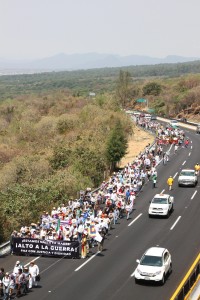
Mexico’s march for peace started yesterday with some 800 protesters taking to the highway on a four-day trek from Cuernavaca to Mexico City.
Cuernavaca, a large city south of the capital, has a reputation as a get-away spot with a springlike climate and blossoming bougainvilleas. Since President Felipe Calderon launched the war on drugs, and especially since the government killing of leader of the Beltran Leyva drug cartel, it has become a hot spot for violence, with cartel-imposed curfews and military checkpoints. The assassination of the son of poet Javier Sicilia and several of his friends there on March 28 was the catalyst for the nation-wide demonstration.
In an interview en route, Sicilia said, “The justice that I demand for my son is the justice I demand for the all the 40,000 dead and all that will follow. We have to put a name to these dead, know their histories, know where they are from, how many were innocent, how many were criminals, why they became criminals, what happened to the communities they came from…
“These people aren’t just ‘collateral damage’ or abtractions, they have families and names, the families are broken, they will never be the same. Mexico can’t go on killing itself like this.”
Men and women who remember the names of the victims all too well marched alongside Sicilia. One of them is Luis Rodriguez from Ciudad Juarez. Rodriguez’s daughter was shot in the massacre of Villas de Salvarcar, Ciudad Juarez on January 31, 2010–another historic moment in Mexico’s drug war when bereaved residents stood up and accused the president of responsibility in the violence.
“We’re here to accompany the pain and the grief of Morelos, and to protest,” Rodriguez said. “Ciudad Juarez is the laboratory of the government strategy, so our mission is to go to places that haven’t been through this and warn them that they have to stand up and organize. Because the government is going to the other cities and if there isn’t organization, it’s possible that the experience of Ciudad Juarez will be repeated.”
When asked how his daughter was, Rodriguez replied, “Physically she’s better now, but mentally she’ll never be the same.”
The Bishop of Saltillo, Coahuila Raul Vera, expressed the positive aspects of a march born of grief. When asked why he joined the march, he replies, “Finally, there’s a movement in Mexico that is beginning to build the society we want. We can’t lose this opportuity to help out. The church can’t be absent in this moment.”
Vera is another strong critic of the Calderon administration’s drug war strategy. “The strategy is wrong, and it’s leaving out the most important part–eliminating political corruption and finanical corruption, the foreign interests and businessmen that give them the money. If the government doesn’t put more emphasis on this part, going around using the military to shoot hitmen just means that tomorrow [the cartels] have the moeny to hire others,” Bishop Vera explained. “There’s no end to it with the way they are doing it now–it’s just going to get worse.”
Julian Contreras, an organizer from Villas de Salvarcar and member of the Plural Front of Ciudad Juarez, said, “We are in solidarity with the demand for peace with justice and dignity and we are adding our demand for the immediate demilitarization of our city and the country.”
As he waited for a lunch provided by local residents, Contreras explained his motives for traveling from the northern border to participate. “By being together we lose the fear of living in fear. We’re going on to Mexico City where they’re are more people waiting for us. Hopefully this is just the beginning of stopping this absurd and deceitful war. Under the pretext of the war on drug-trafficking, they’re exterminating the lower levels of society.”
After a moment he adds, “We can’t let the logic of war prevail. It’s unacceptable that it’s cheaper to kill the poor than to end poverty.”
As marchers made their way to Mexico City to protest the administration’s drug war, President Felipe Calderon directed some very pointed comments to the growing movement. In a speech commemorating the May 5th Battle of Puebla in 1862, the beleaguered president sought to defend his security policies, and in particular the use of the army in the domestic drug war.
On the defensive, he assailed his critics, “who with good or bad intentions want to see our troops withdraw, our institutions let down their guard and give these criminal groups full rein. Today I tell you this is not going to happen. Because we have the reason, the law and the force, we will win.”
Secretary of Security Genaro Garcia Luna echoed Calderon’s irritation with the demonstration. “It is unthinkable that civil society says that the strategy or vision or focus of attack is wrong.”
The government faces off with a growing movement of mostly young people who call for an end to the war on drugs. The “We’ve had it” theme of the march repeats the “Enough already” cry of the indigenous Zapatista rebellion of 1994. In fact, the indigenous movement has called on supporters to join the marches.
Banners called for peace with justice and dignity and criticized the role of the U.S. in supporting Calderon’s drug war; a map of North America where the U.S. bleeds into Mexico in the shape of pointed guns reads “They provide the weapons, Mexico provides the dead”.
Laura Carlsen is director of the Americas Program of the Center for International Policy in Mexico City at www.americas.org.



